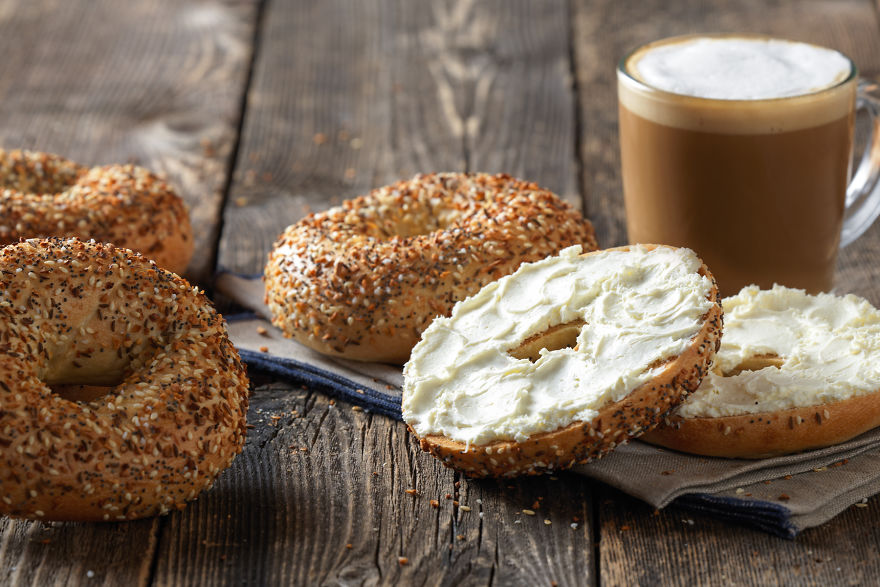A (W)hole Lot More To Bagels Than You Knew
Bagels, we all eat them, but how much do we know about the hole-y goodness? In celebration of National Bagel Day, here are five of my favorite roll with the hole facts to ponder over while eating a bagel yourself.
Bagels Have HOW MUCH Protein?
Surprise! Einstein Bros. Bagels contain 9-17 grams of protein in each bagel, which is more protein than or equal to one large egg, three slices of turkey, one cup of two percent milk or two tablespoons of creamy peanut butter. If you feel like adding even more protein to your breakfast, you can top any protein-packed Einstein Bros. Bagel with egg whites or peanut butter to really make some great protein gains. Whether you are looking for energy to power through your day or to fuel your workout, bagels are a wholesome choice that don’t compromise on taste.
The protein in Einstein Bros’ bagels is plant-based, coming primarily (95%) from enriched wheat flour. The protein is naturally occurring in the wheat, primarily from the wheat gluten. Enriched flour is flour with specific nutrients returned (that were originally present) to it that have been lost while being processed as the bran and germ are removed. The nutrients that enrich the flour include iron and B vitamins (folic acid, riboflavin, niacin, and thiamine). This differentiates enrichment from fortification, which is the process of introducing new nutrients to a food.
Thanks a Lox Poland
First things first, although widely debated, the first origins date back to the Polish-Jewish ghettos of Eastern Europe. Some say the first bagels were created in 1610, in Krakow, Poland where bagels were given as a popular gift to women in childbirth. Others debate this fact and say in 1783, bagels were created to honor King John III Sobieski of Poland after he protected Austria’s people from a Civil War. The common thread between both origins is that the bagel started in Ashkenazi Jewish communities sometime around the 17th century.
A Hole Full of History
A roll with a hole, they said. The hole in a bagel was originally created to be stackable on a dowel (wooden pole) for easy carrying purposes. The word bagel is linked back to Poland in the 16th century and was originally spelled ‘bajgiel.’ until becoming part of the English language in 1932 The Polish word is derived from the German word ‘beugel,’ which means ring or bracelet.
Style Wars
Of course there are different style bagels, but what are the differences? The most common types of bagels are New York style and Montreal style. New York bagels are soft, chewy, and doughy, whereas Montreal bagels are smaller, denser and sweeter. Less known bagel styles consist of East Coast style, Chicago style, and the traditional London Bagel. The East Coast bagel incorporates sourdough, Chicago style bagels are cooked with steam and the traditional London bagel is much harder, with less chew factor.
I Love Bagels To The Moon And Back
Bagels have travelled further than most everyone in the world. They have gone to SPACE! In May 2008, 18 sesame seed bagels travelled to space with astronaut Greg Chamitoff, because he couldn’t live without them for six months. If that isn’t love and dedication, I don’t know what is.
Popularity Contest Results
The award of most popular bagel goes to… The Plain Bagel. The classic and delicious Plain Bagel has the ability to become whatever you want it to be, it can be covered in sweet or savory cream cheese, loaded up with lox or even made into the bread of a sandwich. The versatility of the Plain Bagel is what makes it win most popular every year continuously.
“Toast” bagels this February 9, National Bagel Day. Einstein Bros. Bagels celebrates National Bagel Day by giving away a FREE bagel and Shmear with purchase (not valid at license stores at colleges, airports, hotels or hospitals).
More info: einsteinbros.com
Einstein Bros. Bagels Everything Bagel with Shmear
Bagels, we all eat them, but how much do we know about the hole-y goodness? In celebration of National Bagel Day, here are five of my favorite roll with the hole facts to ponder over while eating a bagel yourself.
Bagels Have HOW MUCH Protein?
Surprise! Einstein Bros. Bagels contain 9-17 grams of protein in each bagel, which is more protein than or equal to one large egg, three slices of turkey, one cup of two percent milk or two tablespoons of creamy peanut butter. If you feel like adding even more protein to your breakfast, you can top any protein-packed Einstein Bros. Bagel with egg whites or peanut butter to really make some great protein gains. Whether you are looking for energy to power through your day or to fuel your workout, bagels are a wholesome choice that don’t compromise on taste.
The protein in Einstein Bros’ bagels is plant-based, coming primarily (95%) from enriched wheat flour. The protein is naturally occurring in the wheat, primarily from the wheat gluten. Enriched flour is flour with specific nutrients returned (that were originally present) to it that have been lost while being processed as the bran and germ are removed. The nutrients that enrich the flour include iron and B vitamins (folic acid, riboflavin, niacin, and thiamine). This differentiates enrichment from fortification, which is the process of introducing new nutrients to a food.
Thanks a Lox Poland
First things first, although widely debated, the first origins date back to the Polish-Jewish ghettos of Eastern Europe. Some say the first bagels were created in 1610, in Krakow, Poland where bagels were given as a popular gift to women in childbirth. Others debate this fact and say in 1783, bagels were created to honor King John III Sobieski of Poland after he protected Austria’s people from a Civil War. The common thread between both origins is that the bagel started in Ashkenazi Jewish communities sometime around the 17th century.
A Hole Full of History
A roll with a hole, they said. The hole in a bagel was originally created to be stackable on a dowel (wooden pole) for easy carrying purposes. The word bagel is linked back to Poland in the 16th century and was originally spelled ‘bajgiel.’ until becoming part of the English language in 1932 The Polish word is derived from the German word ‘beugel,’ which means ring or bracelet.
Style Wars
Of course there are different style bagels, but what are the differences? The most common types of bagels are New York style and Montreal style. New York bagels are soft, chewy, and doughy, whereas Montreal bagels are smaller, denser and sweeter. Less known bagel styles consist of East Coast style, Chicago style, and the traditional London Bagel. The East Coast bagel incorporates sourdough, Chicago style bagels are cooked with steam and the traditional London bagel is much harder, with less chew factor.
I Love Bagels To The Moon And Back
Bagels have travelled further than most everyone in the world. They have gone to SPACE! In May 2008, 18 sesame seed bagels travelled to space with astronaut Greg Chamitoff, because he couldn’t live without them for six months. If that isn’t love and dedication, I don’t know what is.
Popularity Contest Results
The award of most popular bagel goes to… The Plain Bagel. The classic and delicious Plain Bagel has the ability to become whatever you want it to be, it can be covered in sweet or savory cream cheese, loaded up with lox or even made into the bread of a sandwich. The versatility of the Plain Bagel is what makes it win most popular every year continuously.
“Toast” bagels this February 9, National Bagel Day. Einstein Bros. Bagels celebrates National Bagel Day by giving away a FREE bagel and Shmear with purchase (not valid at license stores at colleges, airports, hotels or hospitals).
More info: einsteinbros.com




3
0